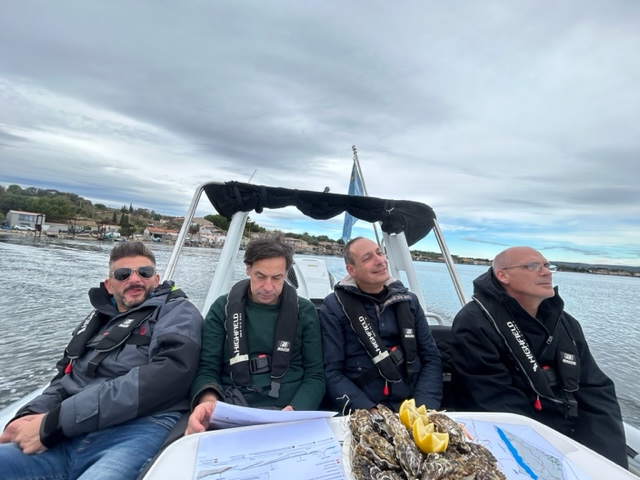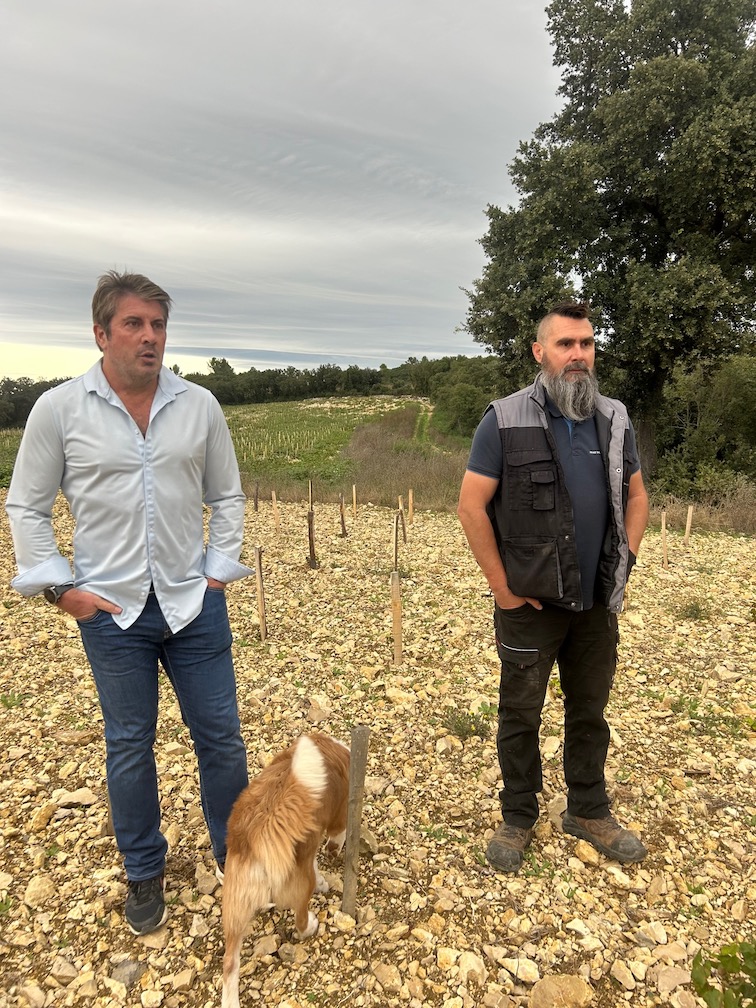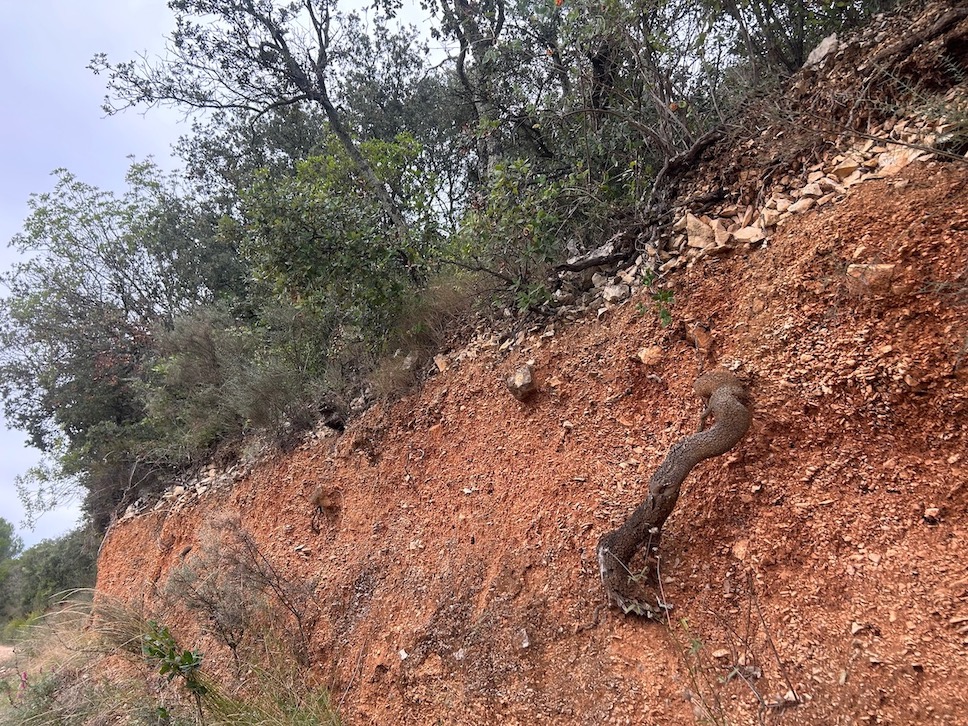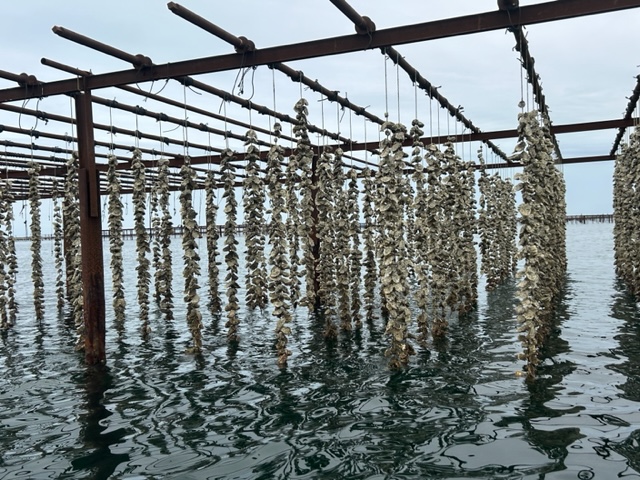Of vines, wines, feasts, oyster-education – and absent Picpoul
On the second day of the Pyrenees’s jaunt around Southern France–not-so-bright and definitely earlier than we would wish–we left our hotel to drive 50 minutes to Mas de Daumas-Gassac, the legendary domaine nestling in the Vallée de Gassac near Aniane.
We are greeted by Samuel and Benjamin and some restorative breakfast pastries, before clambering into an assortment of cars and pickups to pootle up a rough road to a newly-planted Chardonnay vineyard on rocky white limestone near the top of one of the hills, where we can survey the spectacular vista and listen to Samuel and the vineyard manager talk about both the specifics of the vineyards and the holistic nature of their work.
What many people in the wine trade don’t perhaps realise is that Daumas Gassac is more than a winery that produces estate wines or a brand flying the banner for quality in the Languedoc, it is also a project based on developing a living, breathing oasis of vines-in-nature in a desert of monoculture and creating a legacy for future generations to enjoy. More on this anon.
Geographically, as well as geologically, the first thing one notices is not the clearings, home to micro-parcels of vines (usually one-hectare or smaller in size) but the myriad clumps of trees and plants that clad the hillsides. This is a green environment. The land looks refreshed and cool, and one can imagine even when the temperatures soar that the garrigue has a calming effect on the surrounds and allows the vines to breathe more easily.
Mas de Daumas-Gassac: Theatre of Vines
Walking up the Gassac hill is an education of the senses. You feel like you are in a special place.
When the Guiberts first purchased their farm (the mas) in the Gassac valley, they little realised that they had a special micro-climate which would give them the potential to make great wines. A visiting professor from Bordeaux, one Henri Enjalbert, identified a particular red soil that was common to certain great estates in the Médoc and Grand Cru Burgundies. Under the thick garrigue scrub and shrubs covering the Arboussas hills, he found some 40 hectares of perfectly-drained soil, poor in humus and vegetable matter, rich in mineral oxide (iron, copper, gold etc). Formed from deposits carried in by the winds during the Riss, Mindel and Guntz glacial periods (ranging from 180,000 – 400,000 years ago) the terroir provided (and provides) the three elements necessary for a potential grand cru: deep soil ensuring the vines’ roots delve deep to seek nourishment; the excellent drainage ensuring the vines’ roots are unaffected by humidity; poor soil meaning that vines have to struggle to survive, an effort which helps to create exceptionally fine aromas. Rock, scrub and tree clearing began in 1971 and the first vines, principally Cabernet Sauvignon, were planted on the 1.6ha plot just above the winery. At the end of our vineyard tour we walk by a seam of iron-rich red glacial clay.
Mineral-rich soil is only one element in the Gassac cocktail. You only have to stand in the vineyards to engage with the subtleties of the micro-climate. The hill is thick with the aforementioned garrigue; strong warm scents of wild herbs imprint themselves in the air; the quality of light is fantastic. The vines are planted in small clearings, magical glades hidden in the forest. The complexity of Daumas Gassac wines derives heavily from these scents of myriad Mediterranean wild plants and herbs: bay, thyme, rosemary, lavender, laburnum, fennel, wild mint, lentisque, strawberry trees…
It’s all part of the ‘terroir’ effect, that combination of soil, climate and environment that sets one wine apart from another, sadly an effect that is lost in modern monoculture, where huge areas are cleared of all vegetation except vines. At nightfall, the cold air from the Larzac plateau (850 metres) floods into the Gassac valley, with the result that, even in the height of summer, the vineyards benefit from cool nights and moderate daytime temperatures. The northern facing vineyards accentuate the beneficial effect of this cool micro-climate by ensuring they are exposed to less direct sunshine during the hot summers. The micro-climate also means that the vines flower some three weeks later than the Languedoc average which in turn is significant factor in creating the outstanding complexity and finesse of the red wines, most especially the splendidly fine balance of the great vintages’ alcohol-polyphenol-acid content.
Yes, the Gassac valley is an energising place, full of beauty, and reminds one that it is the sacred role of the vigneron to coax the beauty from such an environment into the bottle.
The Guibert family inherited a virgin land free of any pesticide or chemical – nothing had ever been sprayed on the Gassac terroir when they started working it – the only fertilizer came straight from the animals and no heavy machinery had ever been used on that soil. Aimé and Veronique Guibert made the conscious decision to adopt the same approach, fully respectful of Mother Nature, when they started the vineyard… No chemicals, no pesticides, use of natural manure, indigenous yeast, and very small machines…. But the most important decision they ever made was not to cut down any trees, thereby preserving the natural habitat and ecosystem. Two thirds of the 60+ plots of vines are surrounded by forest; this is proving to be the most impactful decision and a daily blessing. Frost, disease, floods… through each of these dramatic events they’ve witnessed the positive impact of having maintained and nurtured nature as an integral part of the vineyards. Although they may not have anticipated the extent of climate change at the time, these actions set the Gassac domaine on the virtuous path and when Nature is respected, she will generally help in return!
Of course, the project is not just about doing; it is also about continuously observing, listening to the needs of the land and acting accordingly. The Guibert family have become thoroughly attuned to this special place and recognise that farming methods have to be adapted, vineyards replanted, and areas left fallow in order to regenerate the land.
The unifying factor
Just as the Gassac team opt for massale selection of the vines, they welcome people from all walks of life and from all over the world to do harvest. A team of nationalities who bring with them the imprint of their own culture and are happy to be exposed to others. The work that exhausts yet liberates and has the further purpose of delivering previous beautiful grapes which will be transformed into beautiful wine. The harvest feasts which take place every day as a reward for hard work, eating amazing food and drinking great wine. If you ask the Guiberts what makes them proud, it is probably this annual demonstration that wine can be a unifying force.
Of course, they want to make the best wine they possibly can. Or rather the truest wine they can, because vintages are naturally so very different in character. Winemaking is always where art, science, and nature intersect and where the crucial judgment calls are made every day during the vinification process, akin to raising a child before releasing them to the world. Preserving the balance of the wine is what all winemaking actions are targeted at. “Finesse, complexity, balance” comprise the holy trinity that has commanded the winemaking philosophy at Daumas Gassac from the very first day.
This begins in the vineyard, where everything is done by hand in order to respect and preserve the quality of the fruit. The same philosophy is applied when the fruit is received in the cellar. Everything is done manually – emptying each of the 16kg boxes and manually sorting every bunch before feeding it by gravity into the tanks. No sulphur dioxide is used during the vinification and only indigenous yeasts are allowed in the underground cellar of Daumas Gassac. The aim to allow the fruit to express itself as naturally as possible– whether that is the imprint of terroir, or the fruit flavours themselves.
The choice of the picking date determines the quality of the grapes. But with over 40 grapes varieties hand-picked over the course of weeks, there is almost always something ripe and ready to be brought in on any given day. The main job is to keep a constant eye on the vineyards, to taste and tour the different plots 2-3 times a week from early/mid-August onwards to ensure the teams pick grapes according to the philosophy of “finesse, complexity and balance”. This always means maturity but not over-maturity. Although the Gassac valley does benefit from its cool micro-climate, the Guiberts are looking for their team to pick with a maximum of acidity. This acidity is one of the key components of the Daumas Gassac wines – they know they will have plenty of sugar/alcohol, they know they will have lots of flavours, but they also want to have a great level of natural freshness to enliven these wonderful flavours and to form the “spine” of their red and white wines.
The ongoing mission
The Guibert brothers’ objective has been to make the transition from their parents running the estate so smooth that no one could say at any given time “this is the year when the Guibert brothers started at Gassac”. Their quest for excellence at all levels is an ongoing mission, always “seeking better ways to look after the Mother Nature that nourishes us, so, not only do we not harm it but actually protect it, and so it goes into the hands of our children in a better state than that which we inherited.”
Samuel observes:
At Gassac, the Guibert family still live on the estate – before being a “business”, it is our land, the land where we grew up, where we played in the vineyards, building tree houses in the surrounding woods and swimming in the Gassac stream. Our responsibility is to keep that land virgin, free of any negative impact, so that our children, then their own children and theirs…. can do the same. Our responsibility is not to own the land but protect it – there are ways that we can further this and we keep looking for these ways, replanting trees everywhere we can, subdividing vineyards in order to have small plots (rather than large areas), expanding horse ploughing, increasing the number of beehives around the vineyards, expanding our flock of sheep. It is an endless search – and such an exciting one.”
After our tour of the vineyards and winery, we are treated to a gorgeous feast prepared by smiling chef Nicholas who caters for the Gassac workers during the harvest and produces hundreds of lunches. Three haunches of pork is roasting on a rotisserie over vine cuttings, their skin blistering into alluring crackling. Big bowls of olive oil anointed chickpea salad with celeriac remoulade are presented. The pork is duly sliced and comes with the most heavenly ceps and root veggies. The coup de grace is a sensational fig tart with a pissaladière-like pastry base, eliciting sobs of joy from all. We commence with the Rosé Frizant as an aperitif which has never tasted better – time and place and sitting outside at a family-style table contributing to its deliciousness. Benjamin starts opening and pouring Daumas-Gassac mags which go down a treat, but they are as all wines tasted in the light of day in beautiful surroundings with friends and colleagues, inhaled with uncritical joy.
The Tao of Oysters
The day is still young, and we are due at the Etang de Thau for a boat trip and instruction in oyster farming.
The Etang is a salt water lagoon about 21 kilometres long and 8 km wide,) The mean depth of the lagoon is 4.5 metres, but in the central navigation channel it can be 10 metres (33 ft) deep.
Eighteen varieties of shellfish are taken from the lagoon – the most important being oysters. 750 producers farm 2,750 oyster tables and take some 13,000 tonnes annually. This provides for about 8.5% of France’s consumption.
The producers of the Bassin de Thau have developed a very particular method; the breeding of oysters in suspension on ropes.
The oysters come three ways:
Glued one by one – La collée une à une: the spat (oyster from 15 to 30mm), natural or hatchery, is glued with cement (three oysters by three) on ropes then attached in a growing table. After 10 to 12 months, a “conquée” and well-filled oyster is obtained. These characteristics are obtained as the oyster grows without being disturbed by the others and the number of oysters per table is limited.
The “collée de tombée”: using the same principle as above but the spat is replaced by oysters that have already pre-grown on tubes or shells. At the time of collage, the size of the oyster being already well developed, its final shape will be less regular than the one by one glued.

The shell oyster (split) – l’huître de coquille (détroquée): in the natural environment, the spat is collected on shells (eight to ten oysters per shell). The shells are put into “strands” and placed in a production table for a time period of 16 to 20 months. Since the number of oysters on the support is very large, they will not have a regular shape, and their filling rate will be much lower than that of the glued shell.
After this maturing time, all these oysters are “détroquées” (separated), calibrated and packed in bags. They are then re-soaked for a minimum period of ten days, while waiting to be commercialised. This re-soaking period will allow them to recover from any damage to their shells.
Oysters from the Etang de Thau are marketed under the name huîtres de Bouzigues after the village where oyster production started. They are a cupped variety. Thau water is graded A, and so shellfish can be caught and consumed within minutes. In addition to oysters, some 3,000 tonnes of mussels are produced every year.
After our tutorial, we are allowed to eat our oysters from the tray at the back of the boat. A green-gold wine is poured into our expectant wine glasses. Finally! The moment I have been waiting for all my life – the holy salty marriage of huitres de Bouzigues and Picpoul. On a boat. Surrounded by oyster tables. But no! Vermentino has been proffered instead. In the words of Wayne Campbell: No Picpoul? Denied!
The evening ended with a party thrown by Benjamin and Samuel for us at Domaine de Pelican, a lovely hotel run by former Gassac-employees, Miyo and Renaud, in Gignac. The building is a restored Languedoc farmhouse on a winegrowing property, surrounded by vines and scrubland overlooking the valley.
The surprise of the evening is a disco which eventually lures even the most reluctant shape-cutters to strut some form of their stuff on the floor, plentifully fuelled it has to be said, by some wonderful old vintages of Gassac poured from magnum. The food flowed as the wine; it was all a wonderful indulgence and testament to the hospitality of Samuel and Benjamin. Great memories, all captured in incriminating polaroids for future blackmail exercises!
*
Interested in finding out more about the wines of Mas de Daumas-Gassac? Contact us directly:
shop@lescaves.co.uk | sales@lescaves.co.uk | 01483 538820






